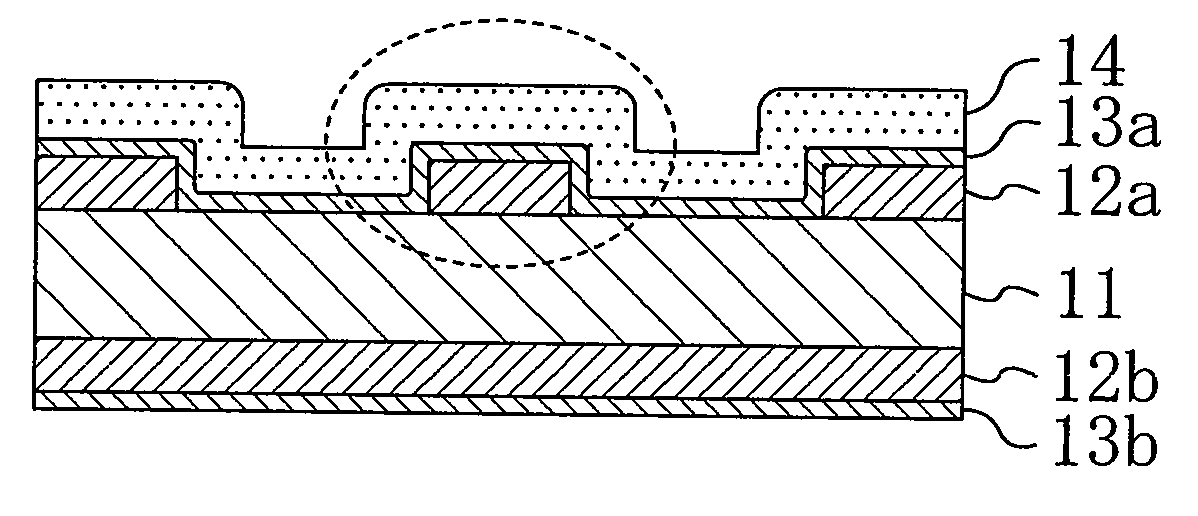MEMS diaphragm structure and method for forming the same
a diaphragm and diaphragm technology, applied in the field of acceleration sensors and pressure sensors, can solve the problems of difficult to freely vary and the amplitude of the diaphragm cannot be freely varied, so as to improve the resistance of the diaphragm against film breakage, easy to form, and easy to rounded
- Summary
- Abstract
- Description
- Claims
- Application Information
AI Technical Summary
Benefits of technology
Problems solved by technology
Method used
Image
Examples
embodiment 1
[0091]A MEMS diaphragm structure having a hinge and a method for forming the same according to Embodiment 1 of the present invention will be described below with reference to the drawings.
[0092]FIGS. 1A through 1F are cross-sectional views illustrating respective steps of the method for forming the diaphragm structure of Embodiment 1.
[0093]First, as illustrated with FIG. 1A, a first film 12a is formed on an upper surface of a silicon substrate 11. Here, the first film 12a desirably has a thickness of greater than or equal to about 100 nm, because the thickness of the first film 12a is a parameter which determines the height (level difference between the highest position and the lowest position in the diaphragm) of a hinge structure of a diaphragm which is to be finally formed. Moreover, since the first film 12a is finally removed by etching, the first film 12a is desirably a silicon oxide film. A silicon oxide film can be formed by thermal oxidation, low pressure CVD, plasma CVD, or...
embodiment 2
[0102]A MEMS diaphragm structure having a hinge and a method for forming the same according to Embodiment 2 of the present invention will be described below with reference to the drawings.
[0103]FIGS. 3A through 3H are cross-sectional views illustrating respective steps of the method for forming the diaphragm structure of Embodiment 2.
[0104]First, as illustrated with FIG. 3A, a first film 22a is formed on an upper surface of a silicon substrate 21. Here, the first film 22a desirably has a thickness of greater than or equal to about 100 nm, because the thickness of the first film 22a is a parameter which determines the height of a hinge structure of a diaphragm which is to be finally formed. Moreover, since the first film 22a is finally removed by etching, the first film 22a is desirably a silicon oxide film. A silicon oxide film can be formed by thermal oxidation, low pressure CVD, plasma CVD, or the like. In the case of using thermal oxidation or low pressure CVD, a silicon oxide fi...
embodiment 3
[0117]A MEMS diaphragm structure having a hinge and a method for forming the same according to Embodiment 3 of the present invention will be described below with reference to the drawings.
[0118]FIGS. 5A through 5H are cross-sectional views illustrating respective steps of the method for forming the diaphragm structure of Embodiment 3.
[0119]First, as illustrated with FIG. 5A, a first film 32a is formed on an upper surface of a silicon substrate 31. Here, the first film 32a desirably has a thickness of greater than or equal to about 100 nm, because the thickness of the first film 32a is a parameter which determines the height of a hinge structure of a diaphragm which is to be finally formed. Moreover, since the first film 32a is finally removed by etching, the first film 32a is desirably a silicon oxide film. A silicon oxide film can be formed by thermal oxidation, low pressure CVD, plasma CVD, or the like. In the case of using thermal oxidation or low pressure CVD, a silicon oxide fi...
PUM
 Login to View More
Login to View More Abstract
Description
Claims
Application Information
 Login to View More
Login to View More - R&D
- Intellectual Property
- Life Sciences
- Materials
- Tech Scout
- Unparalleled Data Quality
- Higher Quality Content
- 60% Fewer Hallucinations
Browse by: Latest US Patents, China's latest patents, Technical Efficacy Thesaurus, Application Domain, Technology Topic, Popular Technical Reports.
© 2025 PatSnap. All rights reserved.Legal|Privacy policy|Modern Slavery Act Transparency Statement|Sitemap|About US| Contact US: help@patsnap.com



